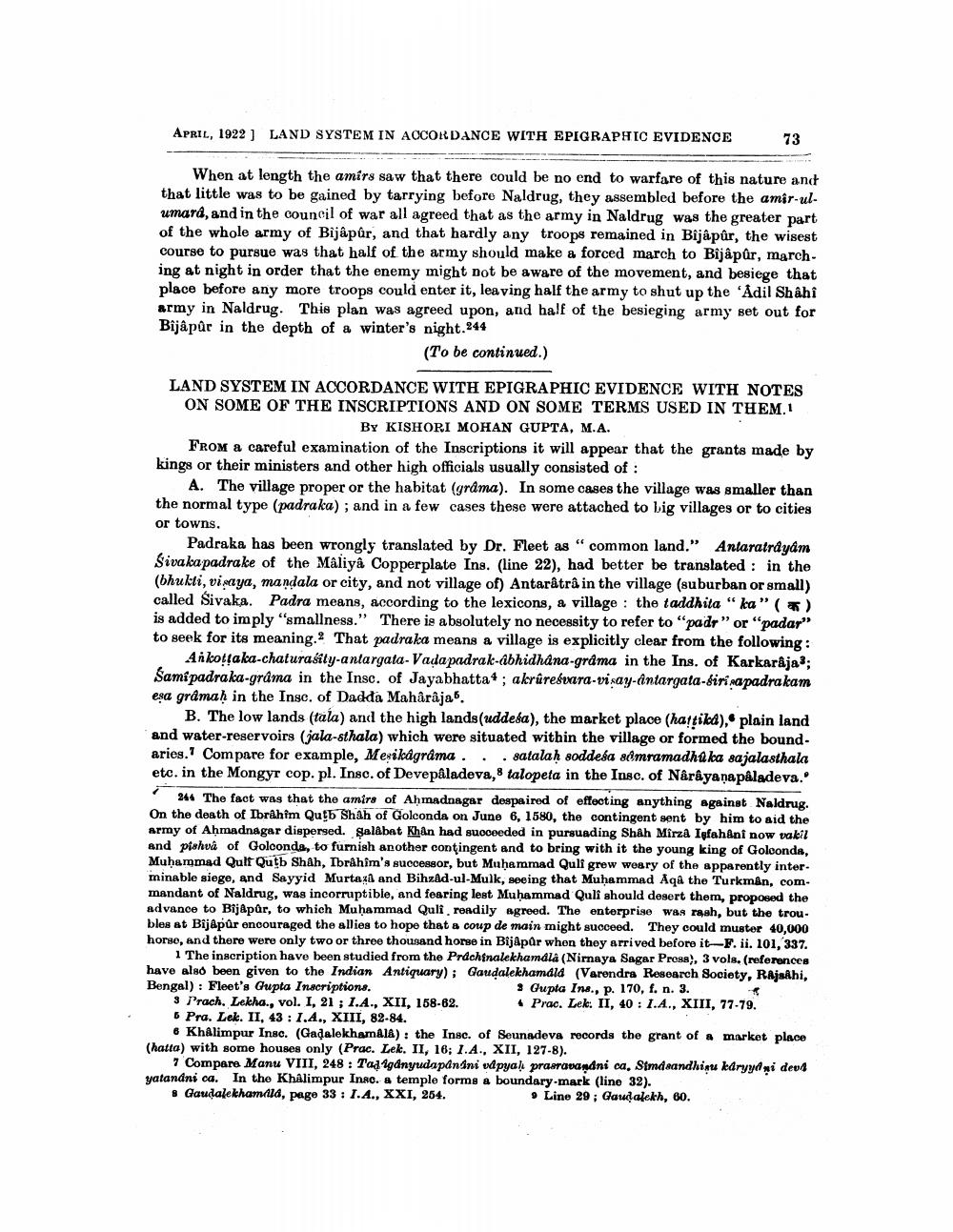________________
APRIL, 1922) LAND SYSTEM IN ACCORDANCE WITH EPIGRAPHIC EVIDENCE
73
When at length the amirs saw that there could be no end to warfare of this nature and that little was to be gained by tarrying before Naldrug, they assembled before the amir-ulumard, and in the council of war all agreed that as the army in Naldrug was the greater part of the whole army of Bijapur, and that hardly any troops remained in Bijâpûr, the wisest course to pursue was that half of the army should make a forced march to Bijâpûr, marching at night in order that the enemy might not be aware of the movement, and besiege that place before any more troops could enter it, leaving half the army to shut up the 'Adil Shahi army in Naldrug. This plan was agreed upon, and half of the besieging army set out for Bijâpûr in the depth of a winter's night.244
(To be continued.)
LAND SYSTEM IN ACCORDANCE WITH EPIGRAPHIC EVIDENCE WITH NOTES ON SOME OF THE INSCRIPTIONS AND ON SOME TERMS USED IN THEM.
BY KISHORI MOHAN GUPTA, M.A. From a careful examination of the Inscriptions it will appear that the grants made by kings or their ministers and other high officials usually consisted of:
A. The village proper or the habitat (gráma). In some cases the village was smaller than the normal type (padraka); and in a few cases these were attached to big villages or to cities or towns.
Padraka has been wrongly translated by Dr. Fleet as “common land.” Antaratrdyam Sivaka padrake of the Mâliyâ Copperplate Ins. (line 22), had better be translated : in the (bhukti, visaya, mandala or city, and not village of) Antarâtrâ in the village (suburban or small) called Sivaka. Padra means, according to the lexicons, a village : the taddhita "ka" (*) is added to imply "smallness." There is absolutely no necessity to refer to "padr" or "padar" to seek for its meaning. That padraka means a village is explicitly clear from the following:
Aikottaka-chaturasity-antargata-Vada padrak-abhidhana-grdma in the Ins. of Karkarája?; Sami padraka-grama in the Insc. of Jayabhatta; akrûreśvara-visay-antargata-firi apadrakam eşa gramah in the Insc. of Dadda Mahârâja.
B. The low lands (tala) and the high lands(uddesa), the market place (hartika).. plain land and water-reservoirs (jala-sthala) which were situated within the village or formed the boundaries. Compare for example, Mexikågrama..satalah soddeća sdmramadha ka sajalasthala etc. in the Mongyr cop. pl. Inso. of Devepaladeva, 8 talopeta in the Insc. of Narayana pâladeva.
244 The fact was that the amirs of Ahmadnagar despaired of effecting anything against Naldrug. On the death of Ibrahim Qutb Shah of Golconda on June 6, 1580, the contingent sent by him to aid the army of Ahmadnagar dispersed. Şal@bat Khan had succeeded in pursuading Shah Mirza IsfahAni now vakil and pishva of Goloonda, to furnish another contingent and to bring with it the young king of Goloonda, Muhammad Qult Qutb Shah, Ibråhim's successor, but Muhammad Qull grow weary of the apparently interminable siege, and Sayyid Murtaxi and BihzAd-ul-Mulk, seeing that Muhammad Aqa the Turkmén, com. mandant of Naldrug, was incorruptible, and fearing lest Muhammad Quli should desert them, proposed the advance to Bijapur, to which Muḥammad Qull readily agreed. The enterprise was reah, but the troubles at Bijapur oncouraged the allies to hope that a coup de main might succeed. They could muster 40,000 horse, and there were only two or three thousand horse in Bijápûr when they arrived before it-F. ii. 101, 337.
The inscription have been studied from the Prdchfnalekhamdla (Nirnaya Sagar Pross), 3 vols. (references have also been given to the Indian Antiquary); Gaudalekhamdid (Varendra Research Society, RAjsâhi, Bengal) : Fleet's Gupta Inscriptions.
9 Gupta Ins., p. 170, f. n. 3. 9 Prach. Lekha., vol. I, 21 ; 1.A., XII, 158-82.
Prac. Lek. II, 40 : 1.A., XIII, 77-79. 5 Pra. Lek. II, 43 : 1.A., XIII, 82-84.
6 KhAlimpur Insc. (GadalekhamAIA): the Insc. of Seunadeva records the grant of a market place (hatta) with some houses only (Prac. Lek. II, 16; 1.A., XII, 127-8).
7 Compare Manu VIII, 248 : Tad igdnyudapdnini vápyal prasravandni ca. Simdsandhin kdryydyi devy yatandni ca. In the Khalimpur Inso. a temple forms a boundary-mark (line 32). & Gaudalekhamdia, pege 33 : 1.A., XXI, 254.
Line 29; Gaudalekh, 80.




